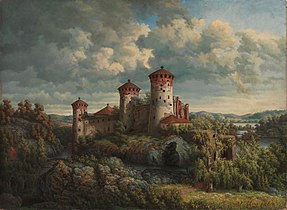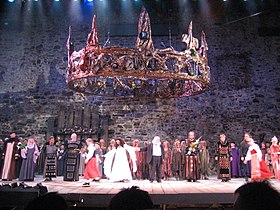Olavinlinna
| Olavinlinna | |
|---|---|
 The castle in 2020 | |
| Alternative names | Olofsborg St. Olaf's Castle |
| General information | |
| Architectural style | Castle |
| Town or city | Savonlinna |
| Country | Finland |
| Coordinates | 61°51′50″N028°54′04″E/ 61.86389°N 28.90111°E |
| Construction started | 1475 |
Olavinlinna(also known asSt. Olaf's Castle;Swedish:Olofsborg;German:Olafsburg;lit. 'Olof's Castle') is a 15th-century three-tower castle located inSavonlinna,Finland.It is built on an island in the Kyrönsalmi strait that connects the lakesHaukivesiandPihlajavesi.It is thenorthernmostmedievalstone fortress still standing.[1] The castle forms a spectacular stage for theSavonlinna Opera Festival,which was held for the first time in the summer of 1912.[2]
History
[edit]

The fortress was founded byErik Axelsson Tottin 1475 under the nameSankt Olofsborgin an effort to profit from the political turmoil followingIvan III's conquest of theNovgorod Republic.It was sited inSavoniaso as to lay claim to the Russian side of the border established by theTreaty of Nöteborg.[3][4][5][6]
One of Tott's letters from 1477 includes a passing mention of foreign builders invited to Olofsborg, probably fromReval,where the city fortifications were being extended. It was the first Swedish castle provided with a set of thickset circular towers that could withstandcannonfire. It is not by accident that a network of lakes and waterways forms the setting for the castle, for these would seriously impede a prospective Russian offensive.
The three-toweredkeepwas completed in 1485, and the construction of the outer curtain walls with two towers was initiated immediately. They were completed in 1495. The castle is roughly a truncated rhomboid with keep on the western side of the island and the curtain walls andouter baileyto east. One of the towers of the keep, St. Erik's Tower, has a bad foundation and has since collapsed. One of the towers of Bailey, the Thick Tower, exploded in the 18th century. Abastionhas been built on its place. The castle was converted into aVaubanesquefortin the late 18th century with bastions.[3]
Warfare
[edit]Olofsborg withstood several sieges by the Russians duringthe FirstandSecond Russian-Swedish wars.A brisk trade developed under the umbrella of the castle towards the end of the 16th century, giving birth to the town ofSavonlinna,which was chartered in 1639.[3]
While the castle was never captured by force, its garrison agreed to terms of surrender twice; first to invading Russians on 28 July 1714 and the second time on 8 August 1743, with the latter conflict's peace treaty in form of theTreaty of Åboleading to the castle and the entire region being seceded toEmpress Elizabethof Russia.[3]During the Russian eraAlexander Suvorovpersonally inspected rearmament of the fortress.[7]
Several devastating fires destroyed much of the castle's decor in the 19th century, all of its original furnishings were destroyed.[8]
Border conflicts
[edit]| Border conflict at Nyslott | |||||||||
|---|---|---|---|---|---|---|---|---|---|
| Part of a series ofRusso-Swedish Wars | |||||||||
| |||||||||
| Belligerents | |||||||||
|
| |||||||||
| Commanders and leaders | |||||||||
|
| Unknown | ||||||||
| Strength | |||||||||
| Unknown | 1,000 | ||||||||
| Casualties and losses | |||||||||
| Unknown | Heavy | ||||||||
After the conclusion of theRusso-Swedish War 1495-1497,Sten Sturereturned to Sweden and discovered that a large revolt had begun against him, resulting in theBattle of Rotebrowhere he was deposed in favor ofKing Hans of Denmark.[9]
In August of 1499, the governor ofVyborg,Eric Bielke,received alarming reports about battles against Russian forces who believed Nyslott was rightfully Russian and were attempting to move the border posts to include the town within Russian territory.[10][11]Of the 1,000 Russians that took part in the fighting, only about 200 are said to have been equipped with firearms; the others fought with axes and sabers.[10]In the following battles, the Russians suffered heavy casualties and were repulsed.[12][13][11]
While further details on the battles are not known, they seem to have been limited to the area around Nyslott. On the 14th of September 1504,Eric Bielkewas able to sign a truce lasting 20 years with the Russians. The next major war between Sweden and Russia would not comeuntil 1554.Despite this, there was no guaranteed peace on the border between them, and among other things a letter from 1509 tells that "the enemies of God and Christendom, the intransigent Russians" have ravaged Finland.[10]
Tourism
[edit]The castle hosts several small exhibitions. These include the Castle Museum which displays artifacts found in the castle or related to it, and the Orthodox Museum which displays icons and other religious artifacts both from Finland and Russia.
Olavinlinna is the initial model for Kropow Castle in thebande dessinéeKing Ottokar's Sceptre,an album in the series of Adventures of Tintin created byHergé.[14]
Gallery
[edit]-
Olofsborg inOlaus Magnus'Historia de gentibus septentrionalibus,1555
-
Olavinlinna the way it looked in 1690s before one of the towers had collapsed and another exploded,chalcographyfrom 1762
-
LithographybyPehr Kruskopf,1847
-
A View over the Castle Olavinlinna,Victoria Åberg,1864
-
Olavinlinna by Victoria Åberg, unknown date
-
Painting of the castle in 1870 byOscar Kleineh,before restoration
-
Sketch byHjalmar Munsterhjelm,1873
-
During winter by Hjalmar Munsterhjelm
-
Olavinlinna,Hjalmar Munsterhjelm, 1875
-
Olavinlinna,Väinö Blomstedt,1900
-
Lit in the night
-
Interior
-
Macbethapplause at Savonlinna Opera Festival in 2007
-
Savonlinna Opera in 2017
-
Russian presidentVladimir Putinas a guest of Finnish presidentSauli Niinistöat Savonlinna Opera, 2017
See also
[edit]References
[edit]- ^"Savonlinnan vaiheita".Savonlinna.Retrieved29 June2020.
- ^"Olavinlinna".Savonlinnan Oopperajuhlat.Retrieved29 June2020.
- ^abcd"Olavinlinna Castle History".Kansallismuseo.Retrieved29 June2020.
- ^"Olavinlinna, Kyrön- ja Haapasalmen kulttuurimaisema".Valtakunnallisesti merkittävät rakennetut kulttuuriympäristöt RKY.Retrieved29 June2020.
- ^"Olavinlinna, Savonlinna".Museovirasto Restauroi.Retrieved29 June2020.
- ^Koskela, Hannu (20 July 2017)."Vuonna 1475 Ruotsin Kruunun mahtimies Eerik Akselinpoika Tott perusti linnan Savoon turvaamaan rajaa itäistä vihollista vastaan. Nyt se on oopperan tyylikäs tyyssija".Apu.Retrieved29 June2020.
- ^"Olavinlinnan hurjat tarinat: Vanki karkasi pellavaköyden avulla".Studio55.25 April 2012.Retrieved29 June2020.
- ^Olavinlinna (Finland) Vacation Travel Video Guide,archivedfrom the original on 2021-12-12,retrieved2019-11-02
- ^Sundberg, Ulf (1999).Medeltidens svenska krig(in Swedish) (1st ed.). Stockholm: Hjalmarson & Högberg. p. 369.ISBN9189080262.
- ^abcSundberg, Ulf (1999).Medeltidens svenska krig(in Swedish) (1st ed.). Stockholm: Hjalmarson & Högberg. p. 375.ISBN9189080262.
- ^ab"Erik Turesson (Bielke) - Svenskt Biografiskt Lexikon".sok.riksarkivet.se.Retrieved2023-11-27.
- ^Schybergson, Magnus Gottfrid (1887).Finlands historia(in Swedish). G. W. Edlund.
- ^Styffe, Carl Gustaf (1875).Bidrag till Skandinaviens historia ur utländska arkiver samlade(in Swedish).
- ^Severi Nygård: Tintti Suomessa.Helsingin Sanomat,Kuukausiliite, October 2008.




![Lithography by Pehr Kruskopf [fi], 1847](https://upload.wikimedia.org/wikipedia/commons/thumb/a/a1/Pehr_Kruskopf_-_Sawonlinna%2C_Finland_framst%C3%A4lldt_i_teckningar%2C_vihko_VII.jpg/280px-Pehr_Kruskopf_-_Sawonlinna%2C_Finland_framst%C3%A4lldt_i_teckningar%2C_vihko_VII.jpg)


![Painting of the castle in 1870 by Oscar Kleineh [fi], before restoration](https://upload.wikimedia.org/wikipedia/commons/thumb/e/e7/Kleineh%2C_Olavinlinna.jpg/309px-Kleineh%2C_Olavinlinna.jpg)



![Olavinlinna, Väinö Blomstedt [fi], 1900](https://upload.wikimedia.org/wikipedia/commons/thumb/a/ae/V%C3%A4in%C3%B6_Blomstedt_-_Olavinlinna.jpg/298px-V%C3%A4in%C3%B6_Blomstedt_-_Olavinlinna.jpg)




